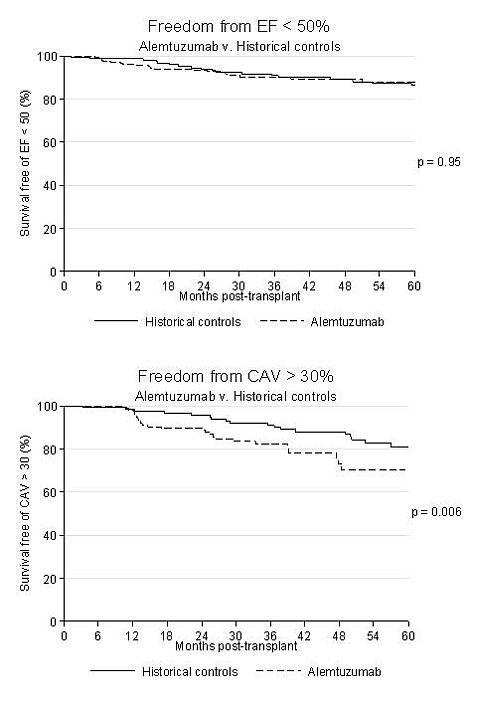Graft Function and Transplant Vasculopathy after Alemtuzumab Induction in Cardiac Transplantation: Five Year Outcomes
Heart and Vascular Institute, Unversity of Pittsburgh, Pittsburgh, PA
Pharmacy and Therapeutics, University of Pittsburgh, Pittsburgh, PA
Meeting: 2013 American Transplant Congress
Abstract number: 205
Purpose: The long-term effects on graft function and vasculopathy with the routine use of alemtuzumab (C-1H) induction therapy and lower intensity maintenance immunosuppression in cardiac transplantation (CTX) is unknown.
Methods: All patients with CTX at a single institution from 1/02 until 9/11. Historical controls used induction for only high risk patients (1/02-10/06), C-1H group used routine alemtuzumab induction. Controls received full dose Tacrolimus (TAC) mycophenolate mofetil (MMF) and, steroids, C-1H received dose-reduced TAC, MMF, and no steroids.
Results: A total of 406 patients were included, 230 in the C-1H group and 176 controls. Baseline characteristics were not different for groups: mean age 55 years, 75% male, 88% white, 52% ischemic, VAD 29%, CMV mismatch 20%. Donor characteristics were not different: mean age 35 years, 65% male, and 78% white. Ischemic time was longer in the C-1H group, 202 v. 182 minutes, p=0.0011. Induction use: C-1H 95% v. controls 36% (87% – thymoglobulin). Maintenance therapy: 99% TAC, 99%MMF. Mean TAC levels were lower for the C-1H v. controls until year 3. Five year survival was similar for C-1H and controls, 73% v. 72% p=0.58 and 5 year freedom from rejection (ISHLT >= 3A/2R) was superior in the C-1H group: 73% v. 56%, p=0.0002. Five year freedom from EF < 50% (for those without primary graft dysfunction) was not different (86% v. 88%, p=0.95) between controls and C-1H. Controls had superior 5 year freedom from vasculopathy (stenosis > 30% in any major vessel) compared to C-1H (81% v. 70%, p=0.006).

Conclusions: Induction therapy after CTX with C-1H results in similar 5 year survival and graft function, superior freedom from significant rejection, but a higher incidence of angiographically evident vasculopathy.
To cite this abstract in AMA style:
Teuteberg J, Zomak R, Newman C, Yost C, Grabowski C, Bermudez C, McNamara D, Kormos R, Shullo M. Graft Function and Transplant Vasculopathy after Alemtuzumab Induction in Cardiac Transplantation: Five Year Outcomes [abstract]. Am J Transplant. 2013; 13 (suppl 5). https://atcmeetingabstracts.com/abstract/graft-function-and-transplant-vasculopathy-after-alemtuzumab-induction-in-cardiac-transplantation-five-year-outcomes/. Accessed December 21, 2025.« Back to 2013 American Transplant Congress
